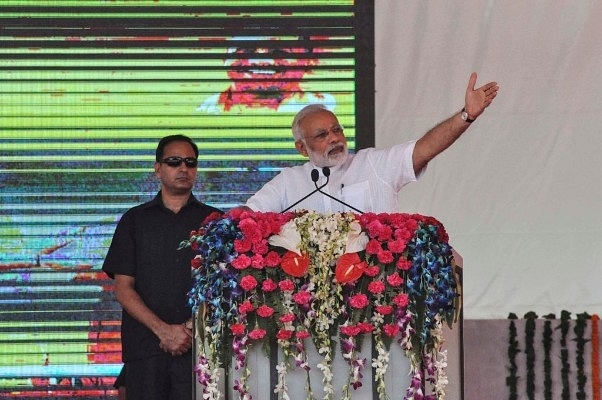Politics
Modi’s Power Reforms In Kashi Reduce Theft And AT&C Losses, Increase Legal Connections And Revenue
- A thick mesh of wires stretching across vast lengths overhead is a common sight in Varanasi, as in other areas, be they villages, small towns or metropolitan areas.
- This model of transmission is responsible for such things as electricity theft, transmission losses and faster degradation of infrastructure.
- Thanks to the Modi government’s initiative, an overhaul of power infra in the city is starting to bear fruit.

Prime Minister Narendra Modi addresses a gathering during a public meeting in Varanasi. (Rajesh Kumar/Hindustan Times via Getty Images)
Known for rhetorical flourishes and quotable quotes, Mark Twain once remarked in his inimitable fashion that Benaras “is older than history, older than tradition, older even than legend and looks twice as old as all of them put together”.
Well, its infrastructure certainly gives that impression.
Anyone who has been to the city and has seen the maze of electrical wires running through narrow lanes can testify to it.
When Prime Minister Narendra Modi, who represents the city of Shiva in Parliament’s lower house, visited Kashi, he joked that there were more wires there than the number of electrical connections, and he asked the officials to do something about it so that some sunrays could penetrate the thick mesh and enter people’s homes and streets.
Varanasi isn’t an exception, however. Whether it is small towns, villages or metropolitan areas, the tangle of wires torments everyone. This is a distressing sight, aesthetics-wise, especially for ancient heritage towns like Varanasi. Not just that, this overhead labyrinthine model of transmission is primarily responsible for a majority of the problems that India’s power sector faces, such as electricity theft, transmission losses, faster degradation of infrastructure due to natural and human factors, which translates to recurring costs, frequent cuts and not to speak of the constant danger to life from the dangling live wires.
In its very first budget, the Modi government announced the Integrated Power Development Scheme (IPDS) scheme, which was launched in Varanasi on 28 June 2015. Though centrally aimed at ensuring 24x7 power to all, it also intended to strengthen the sub-transmission network, metering, provisioning of solar panels at government buildings and so on, and was sanctioned an amount of Rs 572 crore. In the city, one of the themes was to replace overhead cables with underground ones.
Efforts by officials of the central, state and local administration are now starting to bear fruit. The Times of India reported yesterday (23 January) that thanks to an overhaul of power infra in the city, aggregate technical and commercial losses have dropped from 45 per cent to less than 10 per cent in the old area of Benaras; the number of legal connections have increased by 14 per cent as tapping (a way to steal power) became impossible due to underground cabling, leading to improvement in the distribution company’s revenue collection; installing tripping devices has helped detect illegal connections, which has resulted in the filing of more than 100 first information reports; consumer complains have dipped from 8.7 per cent in December 2016 to less than 1 per cent in a year and so on.
The area thus far covered for this transformation runs 8 km along Ganga’s ghats and stretches 2 km from the ghats towards the city, totaling 16 sq km. “The maze of wires and electric poles spoiling the view are gone. We had to lay 1,500 kms of underground cables and all stages of distribution strengthened. In case of a fault, only a cluster of 12 houses now face blackout and not the entire mohalla. Fixing faults is easier because of MCBs and MCCBs installed at transformer sites and substations. Tampering is quickly detected,” the Times of India quoted Powergrid’s Varanasi project manager Sudhakar Gupta on how this change has helped the residents living in the area.
Next, the poles will be removed from the streets, and meters will be installed outside people’s homes. This will bring in more transparency and reduce the chances of theft further.
Support Swarajya's 50 Ground Reports Project & Sponsor A Story
Every general election Swarajya does a 50 ground reports project.
Aimed only at serious readers and those who appreciate the nuances of political undercurrents, the project provides a sense of India's electoral landscape. As you know, these reports are produced after considerable investment of travel, time and effort on the ground.
This time too we've kicked off the project in style and have covered over 30 constituencies already. If you're someone who appreciates such work and have enjoyed our coverage please consider sponsoring a ground report for just Rs 2999 to Rs 19,999 - it goes a long way in helping us produce more quality reportage.
You can also back this project by becoming a subscriber for as little as Rs 999 - so do click on this links and choose a plan that suits you and back us.
Click below to contribute.
Latest